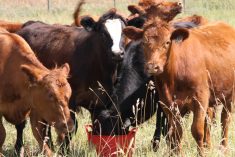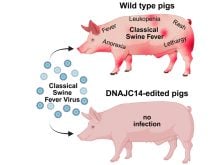IRRICANA, Alta. – When most people think of Brahmans, they associate the breed with bad tempered rodeo bulls.
For a small group of dedicated Canadian Brahman breeders, that perception couldn’t be further from the truth.
Brahmans are commonly seen in the southern United States, but breeders like David Andrews want to see these animals given a chance in Canada. At his Irricana farm, the Brahmans behave like curious pets because they are used to working with people and are treated well.
Denny Crews, beef geneticist at Alberta Agriculture’s research centre in Lethbridge, Alta., said the breed has a special place.
Read Also

The Western Producer Livestock Report – November 6, 2025
Western Producer Livestock Report for November 6, 2025. See U.S. & Canadian hog prices, Canadian bison & lamb market data and sales insights.
Suits the climate
Crews told a group of Brahman breeders at a field day that the breed, originally from southern Florida, is ideal in his part of the world where the temperatures soar to the high thirties and the humidity hovers around 60 percent or better.
About 65 percent of all the cow-calf operations in the United States are based in the south and with the ability to withstand heat, insects and high humidity, Brahmans are common there, said Crews.
In the southwestern United States, many cattle producers prefer a Brahman-Angus cross. They are more pest and heat resistant because of the Brahman bull genetics and are heavier at weaning because of the Angus mother. Others like to cross them with Hereford cows to increase their ability to forage when grass is in short supply.
Brahmans live longer than British or Continental animals and remain productive longer. They reach puberty about five months later than British heifers but produce more calves over a lifespan, Crews said.
A problem for many breeders trying to sell into premium beef markets is the appearance of the Brahman with its floppy ears, large hump on the back and leathery hide that drapes around the legs.
They have received a reputation for producing tougher meat and in today’s quality conscious market, that can mean an automatic knocked-down bid.
“Marketing cows with visual Brahman characteristics can result in price discounts,” said Crews.
It doesn’t matter how untrue those perceptions are, he said.
“One of the issues in the Brahman breed that has to be addressed is which of these perceptions are true and which are not,” said Crews.
Brahmans have found their place in crossbreeding programs and to earn more respect the breeders will have to concentrate on genetic improvement. They will have to emphasize information like expected progeny differences, sire summaries and other evaluation programs.
To take advantage of some of their good qualities, more Americans are including Brahmans in composite breeds to reduce some of the visual problems while retaining the ability to survive harsh southern climates.















